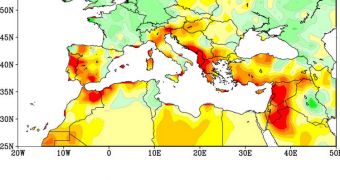A group of investigators from the US National Oceanic and Atmospheric Administration (NOAA) Earth System Research Laboratory (ESRL) announce the discovery of a direct link between human-induced global warming and the frequency of droughts affecting the Mediterranean Basin.
The research team, which is based in Boulder, Colorado, says that the frequency of wintertime droughts all around the Mediterranean Sea is currently increasing at a fast rate, and adds that human-caused climate change is partly responsible for this phenomenon.
The ESRL team collaborated closely with colleagues from the Cooperative Institute for Research in Environmental Sciences (CIRES) for this investigation. In all, the group analyzed climate patterns around the world for the past 20 years.
It surprised the team to learn that 10 of the driest 12 winters that occurred during this interval affected the Mediterranean Basin directly. “The magnitude and frequency of the drying that has occurred is too great to be explained by natural variability alone,” Martin Hoerling, PhD, explains.
“This is not encouraging news for a region that already experiences water stress, because it implies natural variability alone is unlikely to return the region’s climate to normal,” adds the ESRL scientist, who was also the lead author of the investigation.
Details of the work appear in a recent online issue of the esteemed scientific Journal of Climate. The team explains that this dry-winter pattern is very dangerous for southern Europe and northern Africa since this is when the region gets most of its precipitations. Summers there are very dry.
During the study, the experts also found that the drought patterns stretched all the way from Gibraltar to the Middle East. Data collected from observations were augmented with information gleamed from climate models meant to simulate weather patterns over the Mediterranean Basin.
A large number of factors were considered as being possibly responsible for these effects on climate. These included natural variability, a cyclical climate pattern called the North Atlantic Oscillation (NAO), and climate change caused by greenhouse gases.
As much as half of the increased dryness registered between 1902 and 2010 could be accounted for by the release of greenhouse gases from burning fossil fuels. “The question has been whether this projected drying has already begun to occur in winter, the most important season for water resources. The answer is yes,” Hoerling explains.

 14 DAY TRIAL //
14 DAY TRIAL //